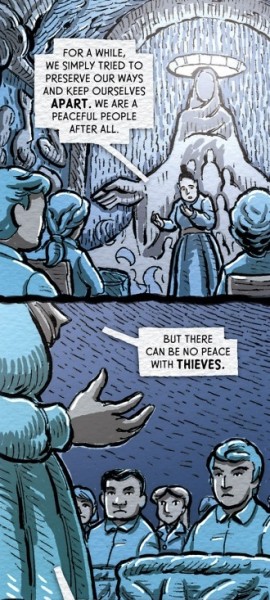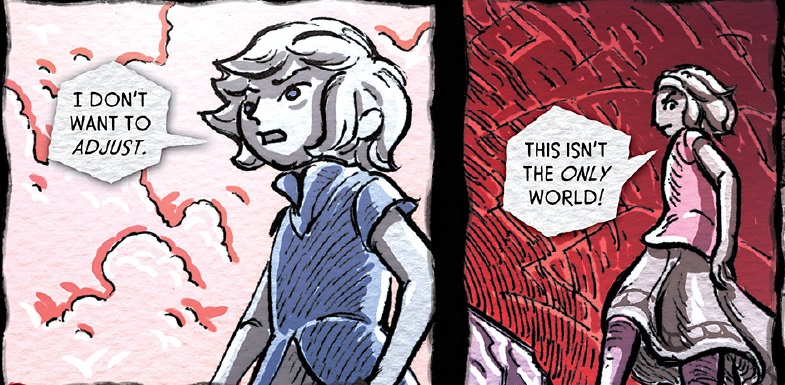In the new video-game-inspired graphic novel Second Quest, a young woman named Azalea who lives in a floating land with a mysterious history begins to see things most people don’t. Touching certain objects, she can glimpse their past, witnessing moments in the lives of other people who have also wielded those objects. But this ability also brings with it a different perspective on her world.
Knowing that not all is what it seems, Azalea starts questioning the conventional wisdom of her society, challenging the stories that say “this is why things are the way they are.” She has begun to suspect that maybe they don’t have to be that way, and that maybe the stories that say they do have to be that way are only told to convince people that this is the way things have to be. But as she dares to question the accepted truths of her world, she faces tremendous resistance. Challenging the status quo is a radical act, and not one that comes without a price.
In October of 2013, the writer of Second Quest, Tevis Thompson, suggested in a different way that maybe things don’t have to be the way they are. Earlier that year, the long-awaited, highly anticipated first-person shooter BioShock Infinite was released to critical acclaim. It earned glowing reviews from every major gaming site, seemingly meeting or surpassing all expectations players might reasonably have for such a game.
But what shapes our expectations for new games? Are our notions of what a game like BioShock Infinite should or shouldn’t do shaped to some degree by game reviews that evaluate whether or not such games do or don’t do very specific things? Should we expect more? Can we even imagine games doing more?

Thompson published a piece called On Videogame Reviews, and in it, he used the critical reactions to BioShock Infinite as a jumping-off point to challenge the entire state of mainstream video game criticism, and by extension, the larger gaming culture it simultaneously served and helped to sustain.
“The straight white male gamers so untroubled by BioShock Infinite, whose ideology and privilege are in fact perfectly reflected in it, are just not up to the task of reviewing on their own. Their subjectivities betray complicity. It’s a dead end, the good old boys speaking to their bros, and only by diversifying in every way possible can the review community thrive,” Thompson wrote. “This means more women, more people of color, more queer and transgender folks, more reviewers from diverse social, economic, and cultural backgrounds that don’t neatly fit the lifelong gamer mold. Not simply because we need reviewers to match the shifting demographics of those playing games, but because diversity is of clear and obvious value to any community and any discourse.”
Given that I was working as an editor at a major video game website at the time, I read the piece with great interest, and not just because Thompson makes specific mention of my review of Grand Theft Auto V and the reactions to that review. It was, for me, a challenging and exhilarating piece of work that illuminated new possibilities. It opened my eyes and encouraged me to ask questions about why we approach games in such a specific and predictable way. Thompson seemed to be pushing up against the established boundaries of video game criticism and video game culture, like a character in a video game pushing up against walls hoping to find a secret passage to a place that might offer a new perspective. The act struck me as an inherently hopeful one. He was saying: Things don’t have to be this way. There can be more.
Reading Second Quest some 18 months after the publication of On Videogame Reviews, what struck me most is how, even though it’s a work of fantasy fiction and not a piece of criticism, in its pages you can still sense Thompson pushing up against the established norms, encouraging us to question the accepted conventions of game design and the assumptions that shape our perception of the world.
The book’s title is a nod to the 1986 game The Legend of Zelda, which featured a second, more difficult quest that made enemies tougher and significantly changed the layouts of the game’s dungeons and the locations of important items. It’s a fitting title, not just because echoes of the Zelda mythos reverberate throughout Second Quest’s story, but also because it is a story about the kind of new beginning that happens when you realize that things aren’t quite the way you expected them to be, and you start to see the world through fresh eyes.

Second Quest is not set in the universe of Nintendo’s Zelda games, nor does it require any familiarity with those games or any other games to be understood and enjoyed. But the way it weaves elements from the Zelda games into its story of a young woman who starts to question the fundamental truths of her culture makes it clear that Thompson and his collaborator, artist David Hellman, are interested in encouraging gamers to question elements of gaming culture as well. Why do we simply accept that so many games present violence as the only way to solve a problem? Why do we accept so many narratives about brave heroes fighting evil and rescuing the girl without ever questioning how the narratives are constructed precisely to leave us with no room to ask questions about whether the bad guys are really so bad or whether what we’re doing is really so good? What is the effect of being told, over and over again, that we’re the hero, the good guy, the chosen one, and that those people over there are evil, and that this is just the way the world is, and that violence is your only option?
Of course, as the passage I quoted earlier from On Videogame Reviews indicates, gaming culture and our wider culture are hardly entirely separate from each other, and therefore, challenging one often involves challenging the other. Second Quest doesn’t need to be interpreted through the lens of video games; it works just as well as a metaphor for a kind of feminist awakening–the sometimes scary but exciting process of starting to perceive and push back against the patriarchal systems and power structures that shape our society. And I don’t want to give away the ending of Second Quest, but I will say that, like On Videogame Reviews, in the end it left me both hopeful and excited. It seemed to say that if we’re willing to not just ask the big questions but follow through to where the answers lead us, things can be so much different, and so much better, than they are now.